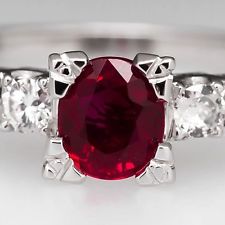
Your ruby jewelry might be worth a fraction of what you paid for it.
Read on to find out why.
(Photo: 11alive.com)
Here's something that really gets me very upset: When a customer walks through the door with a piece of jewelry that contains third rate gemstones. This customer believes she has purchased the best when she shows us her prize possession. I cringe when I think of the next act in this all too common tragedy.
Next, my staff and I have to play the bad guys. It's heartbreaking to see the look on her face as we inform her of its deflated worth; worth thousands less than what she paid. All because someone sold her an low quality gemstone. It's a lousy deal for the customer and for us; the bearers of the bad news. It's unethical and makes me furious! What kind of appalling gemstones do we see? Well, rubies are the biggest offenders right now.
Yes, filling cracks and fissures with lead glass is a common cosmetic treatment to boost the appeal of low-quality rubies. The problem is this: The treatment is dicey; it's so unstable that it can easily be damaged or destroyed. Without extreme care, you'll end up with a ruined ruby. Lead glass-filled rubies are not repairable!
Every day chemicals as common as lemon juice and Dawn dish soap are known to destroy the lead-glass fill and turn a lovely looking ruby into an ugly, fractured mess. These lead glass-filled stones are also a nightmare for bench jewelers doing repairs. Lab tests have shown that the rhodium plating process, heat treatment and jeweler's pickling solution (a cleaning solvent used during resizing) can easily destroy the lead glass fill and even cause filled rubies to crumble. These stones are so fragile that even removal from settings can easily destroy them. Let's face it: They are mainly glass after the fill procedure!
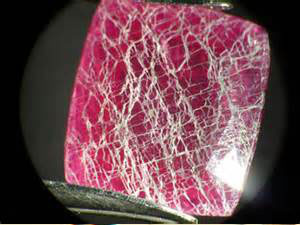
A lead glass-filled ruby that has been ruined.
Note the white, spider web-like veins.
(ajsgem.com.)
Yikes! Can you imagine the angry customers out there who blame their jewelers for destroying their expensive rubies? The problem is they're not expensive. They're crap! Get this: GIA calls lead glass-filled rubies manufactured products." (Wouldn't you want your ruby to be a natural stone?) This prestigious gem lab doesn't even consider them to be real rubies!
A lead glass filled ruby is worth under $10 a carat compared to a natural ruby which currently goes for a few thousand dollars to several thousand dollars a carat. But the lead glass-filled stones are being sold at natural ruby prices! And customers are being told these lead glass-filled rubies are natural, not the manufactured composite crap they truly are.
Yeah, there are ways to detect these inferior rubies if you know what you're looking for. Lead glass-filled rubies give off a blue and/or orange flash under a microscope. They also contain lots of trapped gas bubbles. But in my opinion, if a person spends $1,000 or more on a ruby they should only purchase ones graded by one of the big gem labs: GIA, AGL, AGTA, EGL-USA, GRS, or Stone Group Labs.
Sounds easy enough, right? It's not! That's because big retailers like Macy's have been selling these inferior rubies and assuring their customers they are natural when they are in fact, lead glass-filled. And Macy's is not the only culprit.
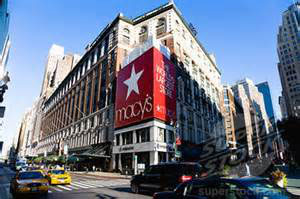
Macy's flagship store in Manhattan.
(Superstock.com)
Inside Edition did an investigation in May of 2014 where they purchased ruby jewelry from Zales and Lord & Taylor in their prestigious Manhattan, New York locations. In both instances, the sales associates assured the undercover buyer that the rubies were genuine. Lab tests revealed that both rubies were in fact lead glass-filled. The ruby ring purchased from Zales cost the investigator $2,000. It's real worth was in the neighborhood of $500. Can you believe this fraud???!
It means you might purchase what you are led to believe is a pricey, high-end ruby, only to be bitterly disappointed. Suppose you accidentally spritzed your ruby ring with juice from a lemon slice while fixing your ice-tea. You might find out the hard way what crap it truly is when you look down at your finger and see white spider web-like veins all over the once beautiful ruby". Let's face it: If popular and high end retailers are pandering in lead glass-filled rubies without disclosing them as such, who can you trust?
So what can ethical jewelers and wary consumers do to avoid purchasing inferior rubies from sources that fail to disclose their true composition? First and foremost, customers must demand in writing that their rubies are natural and do not contain lead glass fill. Jewelers should not deal with these manufactured rubies at all. And they must be sure the proper disclosure has been made to their customers or the proper certifications ensuring treatments are disclosed before handling any rubies. But disclosure isn't the only issue.
HSN (Home shopping Network) is careful to provide links to information about the special care lead glass-filled rubies need. In this information, HSN comes right out and says these treatments are not considered permanent or stable." JTV (Jewelry Television) is not so forthcoming. They say their lead-glass-filled ruby rings aren't sizable but they don't explain the reason why. And they do not have links to special care provisions for their lead glass-filled rubies like HSN does. So in this case, even though there is disclosure, there is no warning of how unstable lead glass-filled rubies can be!
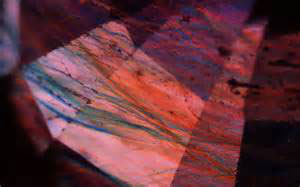
Blue and orange flashes.
(gia.edu)

Trapped gas bubbles.
(gemmannews.wordpress.com)
How do independent small retailers address these concerns? Well I asked another jeweler what they do. At Julie's Place Antiques & Collectibles in Endwell, NY, owner Julie Spisak and her gem buying partner, Carl Sissenstein, have been in the business of buying fine jewelry for over 30 years. We don't buy rubies off the street. There are too many questionable rubies out there like the lead glass-filled type, says Carl. A consummate gem expert and collector, Carl adds, If it doesn't have a fiery red fluorescence like a true Burma ruby should, I'm not interested." And since it's illegal to import prized Burmese rubies into the U.S. anymore, he knows he won't see any of them soon.
Just to give you an idea of how a truly valuable ruby from Burma is compared to the lead glass-filled crap: Sotheby's just sold a 25.59 carat Burmese ruby mounted in a diamond ring called the Sunrise Ruby for 30.3 million dollars. That's 1.1 million dollars a carat, folks! Natural rubies don't come any better than that.
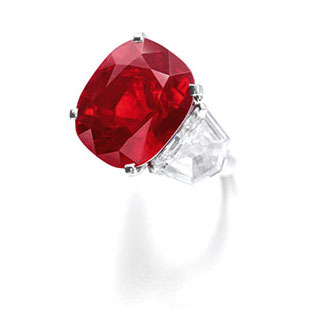
SOTHEBY'S RUBY RING
Listen, I know we can't all pay $1.1 million per carat for rubies. But we should all know what we are buying and it should be priced accordingly! And in my opinion, consumers should steer clear of lead glass-filled rubies altogether. Don't get taken advantage of. If the ruby is over $1,000 then make sure it has a lab report - or don't buy it. Do NOT take the jewelers "word" for it. And by all means do not buy expensive "ruby" jewelry pieces from a chain store, department store or on the TV. Let's end this big crappy ruby ruse!
References:
www.jckonline.com/CBS-Investigates-Macys-Lead-Filled-Rubies
www.jckonline.com/Ruby-Ruse-How-Jewelers-Can-Avoid-Glass-Lead-Filled-Rubies
www.InsideEdition.com/Are-They-Really-Rubies
Worlds Most Expensive Colored Gemstone
www.PriceScope.com/Lead-Glass-Filled-Ruby-Nightmare
www.GemologyProject.com
Help your friends not get taken advantage of - please share this


